It was a time of dramatic growth in academics and stature, closing with the biggest challenge faced by a president in the University’s history.
What follows are some of the major events in the tenure of President Richard Davenport.
2002-2008
Richard Davenport’s arrival at Minnesota State University, Mankato as its president was, for him, a culmination of a long long-held desire to lead a great university.
“His entire career up to that point had been very focused on academics,” said Tim Huebsch ’02, the student government leader who picked Davenport up at the airport for his on-campus job interview. Huebsch, who recently concluded a term as Foundation Board president, sat on the search committee that selected Davenport as president.
“And all of a sudden you’re the president, all of a sudden you immediately shift: You’re the public face of an institution, and everything that you spent your entire career up to that time [doing], you have to delegate. And that’s a hard transition to go through,” Huebsch said.
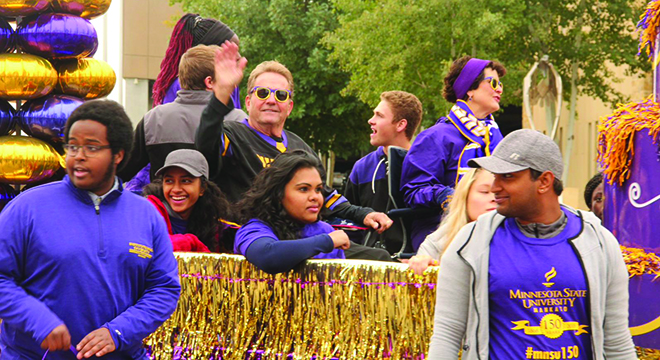
For 12 years, Davenport had served as provost and vice president at Central Michigan University in Mount Pleasant, Mich., which at the time had 27,000 students—compared to Mankato’s 14,000.
During his first year in Mankato, Davenport spelled out his priorities, challenging himself and the University to strengthen diversity, enhance graduate education, energize undergraduate research and build distance learning.
He spent the next 19 years making it all happen.
Sidelined
Two years into his presidency, Davenport made statewide news, albeit for a personal health story. Since childhood, he’d had kidney issues, which flared up to alarming rates after taking office at Minnesota State Mankato. By 2004, he needed a kidney transplant.
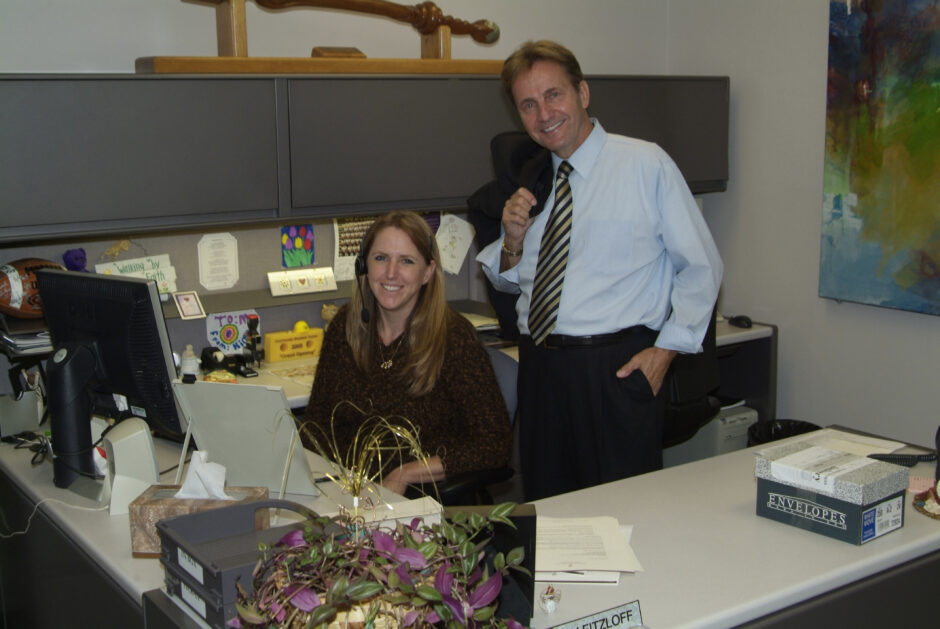
A donor emerged from only a few feet away. Ginny Fitzloff Bessler, an administrative assistant in Davenport’s office, volunteered to donate a kidney, a gesture she had vowed to make when her father passed away years earlier. The transplant successfully took place during Thanksgiving break.
“Ginny is a special person in my life and there is nothing I wouldn’t do for her,” Davenport said recently. “She risked her life to save mine. We are kindred spirits.”
Doctoral Programs
During his presidential interview, Davenport pledged he would fight for the approval to offer doctoral programs, and in the fall of 2005 the Minnesota state legislature made it possible for Minnesota State Mankato to grant doctoral degrees.
It had taken some three decades of trying, but finally a change to state law cleared the path for state universities to offer applied doctoral programs in six areas—nursing, audiology, psychology, education, physical therapy and business. Up to that point, only the University of Minnesota could offer doctorates.
Although the push had been started by previous administrations, Davenport’s determination was credited as well. He had, after all, overseen the installation of many doctoral programs while provost at Central Michigan. As he would prove throughout his time at the University, Davenport made a good impression on Minnesota lawmakers.
“He was able to get the legislature excited about it in a way that hadn’t been ignited in the state before,” said Scott Olson, former provost and vice president for academic affairs at Minnesota State Mankato and now the president of Winona State University. “It was a high priority with President Davenport.”
Minnesota State Mankato immediately made plans to offer doctoral degrees in education, nursing and psychology.
“This is the last stage in our evolution,” Olson said at the time. “When you begin offering doctoral programs, that’s the last, greatest step you can take.”
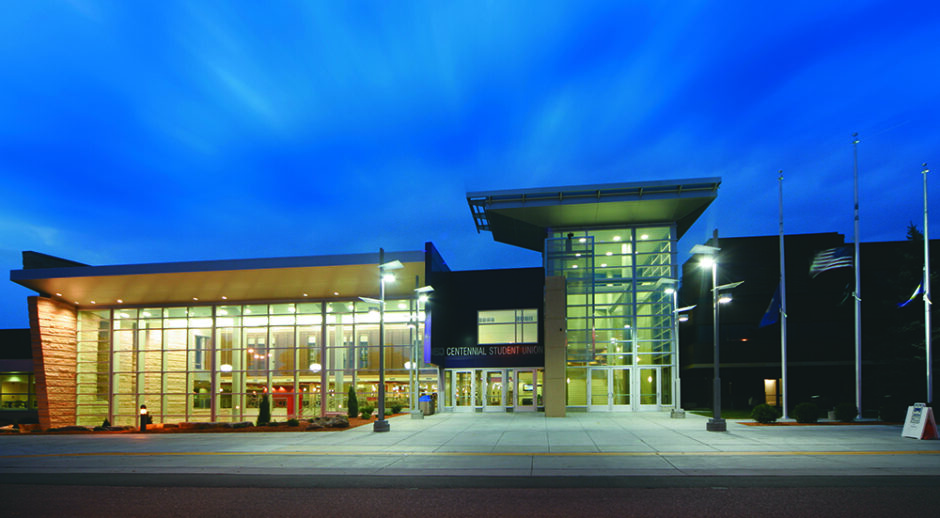
Continued growth
In 2005, two dramatic construction projects were launched to enhance student life on campus. The year saw the first of three phases of renovations to the Centennial Student Union, beginning with the creation of the spacious Hearth Lounge and culminating in the connection of the union and the Memorial Library in 2011.
Campus athletics also received a sharp makeover in 2005 with the $8.4 million renovation of Otto Arena that included new flooring, three basketball/volleyball courts, a jogging track, cardio fitness area, weight room, remodeled locker rooms and a student lounge. It was unveiled on Oct. 1, 2005 in the heart of homecoming weekend.
Divisions
Since the 1996-97 season, the men’s and women’s hockey teams at Minnesota State Mankato have competed at the Division I level—but the other intercollegiate sports compete as Division II. In late 2006, the Division II North Central Conference commissioner announced that the conference would end after the 2007-2008 athletic season. While an option existed to reclassify the programs to Division I, the decision was made to remain at Division II and apply for membership in the Northern Sun Intercollegiate Conference.
Davenport decided the move to Division I would have been too expensive, requiring $2 million per year, all without any guarantee that it would increase attendance or donor support for the University.
“It is highly unlikely that we could develop a viable financial plan for such a move,” he said at the time. “Most of the cost of Division I affiliation would be borne by our students. Our students are already heavily invested in the athletic program, and burdening them with the added costs of Division I affiliation is unfair.”
Former provost Marilyn Wells said Davenport had plenty of push from stakeholders to go to Division I.
“I think one of his wisest decisions was to stay D2,” she said. “Sometimes your legacy is in what you didn’t do. We didn’t go D1. We stayed D2 and are a powerhouse in many sports in that arena.”
2009-2015
The Edina Connection
In an effort to reach non-traditional students in the Twin Cities, the University at Davenport’s direction leased space in a visible office building at 7700 France in Edina, a building owned by alumnus David Frauenshuh.
It was an important move designed to offer flexible scheduling and less travel time for Twin Cities students interested in Minnesota State Mankato programs. The location today offers graduate, undergraduate and doctoral degrees in a number of disciplines.
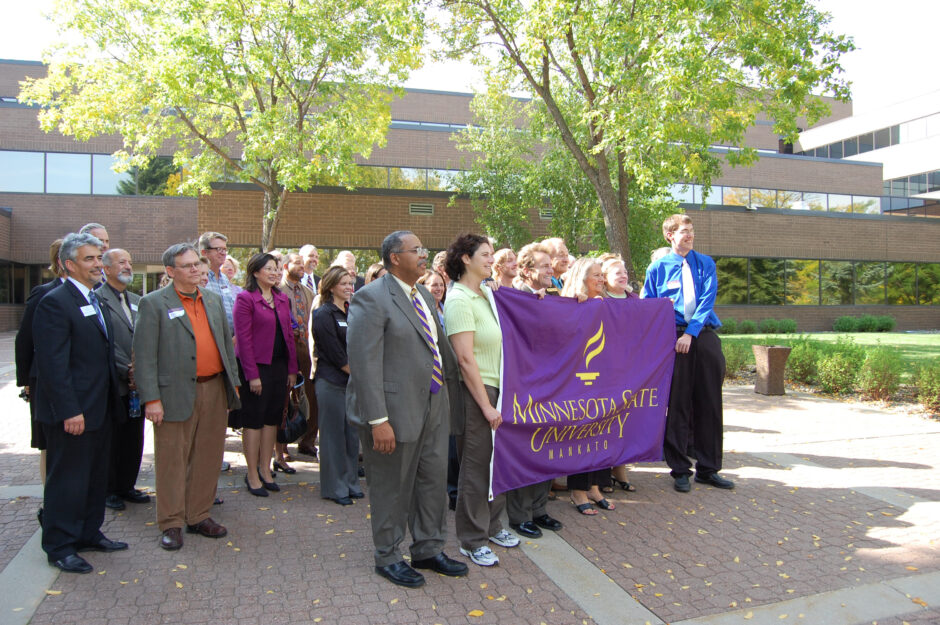
As the doors to 7700 France opened to some 400 students in fall of 2008, a new relationship with Normandale Community College, in which students could take their first two years at Normandale and finish at Minnesota State Mankato, also started.
Such partnerships would be an ongoing priority for Davenport. His knack for establishing partnerships—which he’d done at Michigan—impressed the business-minded members of his hiring committee.
“I remember in the interview … saying ‘Well, I believe in the value of business partnerships,’” Davenport recalled. He mentioned one partnership that he’d worked out with Northwest Airlines. “And they asked, ‘Is that the only partnership?’ I said no, that I had finalized dozens of others. So, they got me talking about partnerships I had entered into all over the country and literally the world. Al Fallenstein, an individual on the search committee, turned to Glen Taylor and said, ‘As far as I’m concerned, we’re done. We’ve got the guy right here.’”
Building boom
Determined to drastically upgrade residential life on campus, Davenport oversaw the construction in 2008 of the 600-bed Julia Sears Residence Community and, four years later, the 300-bed Margaret R. Preska Residence Community.
Those new buildings allowed for the demolition of Gage Towers, which were too expensive to maintain or retrofit. The towers came down in a public demolition in the summer of 2013.
More than 7,000 gathered to watch them fall. “That level of engagement,” Davenport wrote in TODAY, “speaks volumes about what those buildings, and this University, have meant to people over the years.”
Davenport also oversaw the $32.5 million update to Trafton Science Center with the construction of its Ford Hall addition, completed in 2008 as well as the following $27.4 million refurbishing of classrooms and labs. (For a story on more Davenport-era construction on campus, see page 12 in this issue.)
During Davenport’s tenure, nearly $300 million was invested in new construction on campus, plus annual money for repair and replacement.
“Since I’ve been here, the funding that we put into beautifying the campus and to adding new structures and new buildings has made it one of the most attractive campuses,” Davenport said. “For the second largest university in Minnesota and one of the bigger universities in the Midwest, you’re going to have a hard time finding a gem like this.”
A diverse campus
In late 2009, a ‘Strategic Plan Report Card’ was published that gave the president some points of pride in accomplishing many of the challenges he spelled out in 2002.
Along with the launch of 7700 France, the Sears building and an uptick in graduate enrollments, the report noted an additional development: In five years, diversity on campus grew by 153 percent.
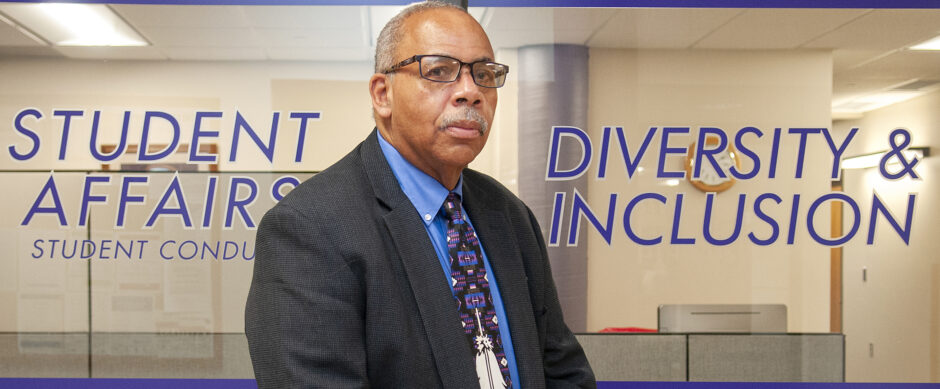
Henry Morris has for the past 12 years served as head of what is now known as Diversity and Inclusion. Morris has worked with Davenport since the latter’s first days on campus—when Morris was executive director of student affairs.
“The student population has surely grown under his presidency,” Morris said, adding that domestic students of color make up about 18 percent of the student population today. Together with international students, they comprise a quarter of the student population.
“When I got here about 30 years ago, domestic students of color population were about 4 percent,” Morris said.
His seat on President Davenport’s cabinet “is a cabinet position in more than name,” Morris said. “[This position] has departments that report to it. It has money to make a difference. Many diversity areas are a staff of one. Even though they may have a nice title, it’s just a staff of one or two.
“When I look at my counterparts across the nation, I think we have one of the premiere diversity and inclusion areas in the nation and definitely for institutions like us—regional comprehensive state institutions. A lot of that is because it was a commitment President Davenport had.”
Former provost Scott Olson said diversity was an ongoing pursuit for Davenport.
“His singular, unwavering commitment—this says a lot about him—was to diversity, equity and inclusion,” Olson said. “This was so close to his heart. Anytime the university could get better at it, he wanted us to. He wanted to advance that in good times and bad, and if we faltered, he felt it really personally. Anytime something didn’t go right for students of color, for female students, for folks who otherwise had been underrepresented in higher ed. He would often say that was his number one thing.”
2016-2021
Progress continued in the final third of Davenport’s tenure. In 2017, the Center for Innovation and Entrepreneurship opened in a downtown building that brought an enhanced University presence to the city of Mankato and a resource for area entrepreneurs, student and non-student alike.
It was a time of celebration, as well. For a year, Davenport was involved in a number of events and observances commemorating the University’s 2018 sesquicentennial. From four instructors and 27 students in 1868 to being the flagship institution in the state university system with around 15,000 students, the University’s celebrations culminated with a downtown parade on homecoming weekend, 2018.
The addition of the 110,000 square-foot Maverick All-Sports Dome, unveiled in 2019, expanded opportunities for the University’s athletic teams, general student population and community groups as well.
By all appearances, 2020 would be another year of progress. It became, however, the largest challenge of Davenport’s professional life.
Pandemic times
With the COVID-19 pandemic, Davenport was confronted not only with the most drastic pivot in the University’s 150-plus years, but a need to take action quickly—not always a trait of institutional decision-making.
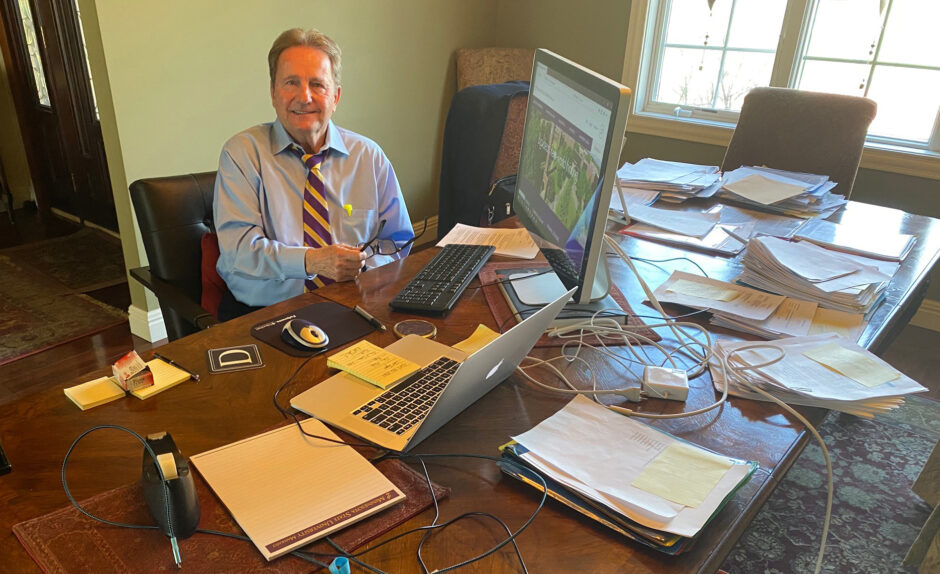
“The health of our students, faculty and staff and others. That was foremost in our mind when we began,” he said in May 2020, by which point the University’s work and learning environments had been transformed to remote operations, leaving the campus all but empty.
In a matter of three weeks, more than 3,000 classes shifted from classrooms, labs and lecture halls to the kitchens, basements and bedrooms of students and professors, all connected online. And while not perfect, it worked.
During those days, Davenport saw the benefits of a focus on student success that he had instituted pre-pandemic. It was an approach designed to make sure students felt cared for and valued.
A good year before anyone would hear of COVID-19, Davenport prioritized student success as a goal moving forward, with that success defined as retention, student completion and closing the racial opportunity gap. “We knew if we could improve that student success, we would grow like wildfire,” Davenport said.
He called upon Lynn Akey to become the Vice President for Student Success, Analytics and Integrated Planning. Akey organized an effort that had among its pillars “demonstrating care in interactions with students.”
In a wide-ranging system, students were checked on, guided and directed toward help when falling behind. Connections were made and appreciated, and when the pandemic upended life on campus, those connections were sorely needed—and provided.
“What we realized in March,” Akey said, “was that suddenly our students had to leave campus for the most part and that everyone was lacking this connection that we had previously enjoyed. There was a real sense that we needed to reach out to our students as we were going through this massive transformation to remote learning.”
Akey and her team recruited staff from around the University to make calls, take questions and work to get them answered. Within a month, nearly every student had been contacted—and Davenport made sure he was involved in taking and answering questions.
“We looked at their problem and say OK, we’re going to figure this out,” Davenport said. “We don’t wait for two days. We do it almost immediately, and I think it gives some sense of relief and confidence in the families that are sending their sons and daughters here.”
The successful exception
A similar approach was taken to that fall’s registration, with faculty volunteering to make calls to registered and prospective students to see how their summer was progressing and if they had any questions about the transition to the fall semester.
The result: In the midst of the pandemic, the University’s enrollment actually grew at a time when most universities saw declines. Like all of the other triumphs of the past 19 years, Davenport credited his colleagues for that good news.
“Behind every single one of those goals and accomplishments, there were a lot of people,” he said. “Not only do we have this fabulous cabinet, and we have a respect for one another, but we have the expanded cabinet who don’t get enough credit. Those deans are out there working just as hard.
“It’s the pride and the willingness to put forth the work and effort to make a difference,” he said. “That’s where we have excelled.”
Davenport, the 12th president of the University, has one of the longest presidential tenures in its history. And that translates into a strong university, said former cabinet member and president of Minnesota State University Moorhead Anne Blackhurst.
“The longer a president can stay, the better it is for a university,” Blackhurst said, “because you avoid that turn that happens throughout the institution every time a president turns over. His ability to do the job over the long term, to hire really good people, to keep them long enough to make a difference has been remarkable.”
Speak Your Mind